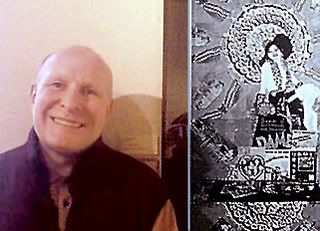
Visit: A Tale of Two Movies
Weather: Sun and rain, sun and rain -- I'll take both.
Charity Alert: The Animal Rescue Site is trying to give 2.7 million bowls of food this month, but they're not even halfway to their goal yet.
Garage Sale Booty: A hand-autographed picture of John Lithgow, and the cast of the very silly TV comedy Third Rock From The Sun. Lithgow owns a vacation home in nearby Lakeside, and is actually a fine, accomplished actor. (I like Kristen Johnson too.) It's a bad idea to hold actors' roles against them -- just watch how well they do their WORK.
A hardbound edition of A Summer Book by Tove Jansson, Finnish author of the great 'Moomin' stories.
A half-dozen almost-new plastic water-catchers for fifty cents.
In The Community: I saw Renata Reiss and her son Henry one last time at the Hockaday yesterday. They are flying home this morning. Those newspaper articles I mentioned brought dozens of people to the museum on Sunday and Monday -- days which are usually slow. My friend Vanessa Peck came in several times -- she loves the Winold Reiss portraits! Hockaday Museum of Art
Hmm -- there's a Hockaday member's meeting tonight at the Chamber of Commerce building. Maybe I oughta go as a spectator for a change.
Media Watch: I finished watching the DVD version of the Buck Rogers serial from 1938 last night.
Buster (Flash Gordon) Crabbe played Flash's space-opera predecessor, in what must have been a confusing production for the myriad fans of Nowlan and Calkins' pioneering spaceman. Visually, there was no mistaking Buck Rogers for Flash Gordon in the newspapers. Alex Raymond's elegant draftsmanship overpowered his competitor's crude doodles, but the inventive, rolicking wild-west adventurousness of Buck Rogers was only IMITATED in the panels of Flash Gordon, and every fan of action movies, books, and comics knew it.
The leaden hand of Ford Beebee weighs heavily on this formulaic merry-go-round -- these chapter serials are literal sideshows relative to the carnival of 30's Cinema. There are opportunities for humor, surprise, and suspense, but they sit in the mind of the viewer of today, unexplored by filmmakers who weren't very imaginative. I may be accused of favoritism, but Crabbe's three other Flash serials all show more exuberance, despite Beebee's ubiquitous prescence.
The only time I saw these particular chapters on television was in 1967, when I was in high school, at the beginning of my career as a comics enthusiast. Even though I wanted to like them, there wasn't much to grab my attention -- they seemed too derivative of the oft-seen Flash Gordon serials, without any fundamental differences to make them special. Unfortunately, Buck Rogers was the LAST chapter serial our local TV stations played in their early morning/late afternoon slots. I enjoyed them while growing up, and I didn't mind studying them as a young adult, despite their weaknesses, but an era passed away right before my eyes, even though it was made up of pre-WWII reruns.
Constance Moore played Wilma Deering, the female protagonist in Buck Rogers. Although she is often criticized as 'passive' or 'un-sexy' in this role, there ARE moments where she is actually alluring, with her fine figure on display beneath that dumpy riding costume and flight helmet. (Accurately reproducing Wilma's uniform in the comic strip.) She even takes off her gilded "shower cap" at least once, sporting a thick mane of curled, dark blonde, neck-length hair. Late in the serial, she also fights effectively -- kicking some serious ass, and swinging a mean ray gun -- while busting Buck (and herself) out of Killer Kane's deepest dungeons. As far as a 'platonic' relationship with her male leading man goes, the final scene of the serial shows Wilma ready to lock loins with him -- or at least enjoy a passionate smooch -- once the cameras stop rolling. Her body language is unmistakable, and the script even declares their mutual intention to embrace!
Ms. Moore was a hard-working big band singer when she wasn't making movies in the Mid-20th Century. Whatever anyone may say about her now, she was an experienced entertainer who knew her craft.
Here's a well-written essay about Buster Crabbe's serials: FLASH GORDON AND HIS UNIVERSAL SERIAL COMPATRIOTS A Critical and Sentimental Perspective - by Tom Aldridge
Fair Warning: I'm going to add some new pages to A Tale of Two Movies -- There's more to say about movie spaceships and re-used footage from Just Imagine.

No comments:
Post a Comment